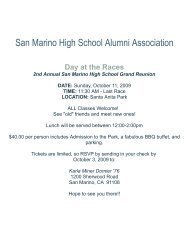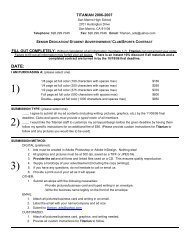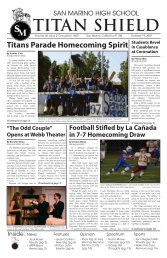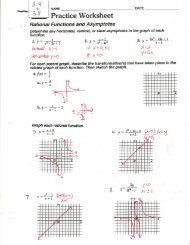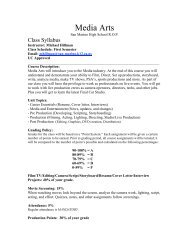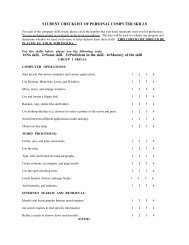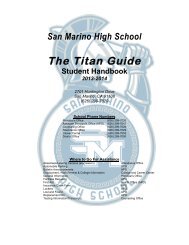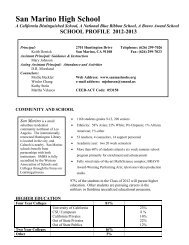Visual Arts Vocab.pdf - San Marino High School
Visual Arts Vocab.pdf - San Marino High School
Visual Arts Vocab.pdf - San Marino High School
Create successful ePaper yourself
Turn your PDF publications into a flip-book with our unique Google optimized e-Paper software.
complementary colors Colors opposite one another on the color wheel. Red/green, blue/orange,<br />
and yellow/violet are examples of complementary colors.<br />
composition The organization of elements in a work of art.<br />
Content Message, idea, or feelings expressed in a work of art.<br />
contour drawings The drawing of an object as though the drawing tool is moving along all the<br />
edges and ridges of the form.<br />
contrast Difference between two or more elements (e.g., value, color, texture) in a<br />
composition; juxtaposition of dissimilar elements in a work of art; also, the degree of difference<br />
between the lightest and darkest parts of a picture.<br />
cool colors Colors suggesting coolness: blue, green, and violet.<br />
curvature The act of curving or bending. One of the characteristics of line.<br />
curvilinear Formed or enclosed by curved lines.<br />
design The plan, conception, or organization of a work of art; the arrangement of<br />
independent parts (the elements of art) to form a coordinated whole.<br />
Distortion Condition of being twisted or bent out of shape. In art, distortion is often used<br />
as an expressive technique.<br />
dominance The importance of the emphasis of one aspect in relation to all other aspects of<br />
a design.<br />
elements of art Sensory components used to create works of art: line, color, shape/form,<br />
texture, value, space.<br />
emphasis Special stress given to an element to make it stand out.<br />
expressive content Ideas that express ideas and moods.<br />
figurative Pertaining to representation of form or figure in art.<br />
Foreground Part of a two-dimensional artwork that appears to be nearer the viewer or in<br />
the front. Middle ground and background are the parts of the picture that appear to be farther and<br />
farthest away.<br />
focal point The place in a work of art on which attention becomes centered because of an<br />
element emphasized in some way.<br />
form A three-dimensional volume or the illusion of three dimensions (related to shape, which is<br />
two-dimensional); the particular characteristics of the visual elements of a work of art (as<br />
distinguished from its subject matter or content).



